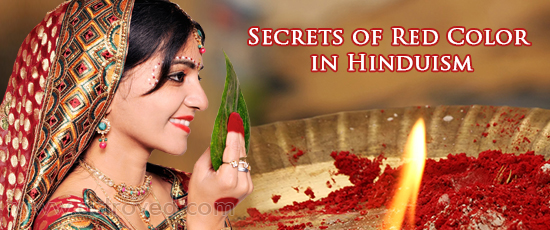Secrets of Red Color in Hinduism
Red symbolises power or Shakti in Hinduism. It is the colour of the Supreme Goddess Adishakti. It represents the purifying fire that destroys evil and attracts divine energies of protection. Hindus invoke the blessings of the Goddess through use of this colour widely during auspicious events like weddings and religious ceremonies. Married women use this colour in their daily lives to enjoy the blessings of longevity of husband, good marital life and prosperity. Marriage and fertility are deeply connected with color red according to ancient traditional Hindu beliefs. They propitiate Goddess Lajja Gowri, the Goddess of fertility for blessings of good marital life.
Symbolism of Red
Red is an auspicious and sacred color used widely in social and religious functions of Hindu culture. It is a symbol of love, ardent affection passion and sacrifice. Scientific research and psychological studies show that red enhances positive feelings and women dressed in red are considered to be attractive to the eyes of men. It is the color of planet Mars.
Hindu Weddings
Red Bridal Sarees
In Hindu weddings, brides wear red sarees. The color is associated with sensuality, fertility and heat. It helps create strong bonds and kindles passion between the couple in their marital relationship. Hindus associate this color with wealth, beauty and Goddess Lakshmi.
It is customary for Hindu brides to wear a red sari during the auspicious occasion of marriage. They use red bridal jewellery and color their hair with henna. This symbolises happiness and joy. Red sari is worn during weddings and during holy festivals.
Red Henna
The other name for henna is mehendi. The bride`s hands are decorated with intrinsic and beautiful patterns of mehendi. The fresh leaves are plucked from the henna plant and made as a paste. This is applied to the hands and feet of the bride to look attractive and also to cool the body. There is a separate ceremony called mehendi ceremony among north Indian Hindus to apply mehendi before marriage.
Red Sindoor or vermilion
The brides in a Hindu wedding, are adorned with a red Sindoor that is applied on the bride`s head by the groom. This is applied on the parting of the forehead of the bride, which symbolizes marriage vows. From that moment, the bride wears sindoor till her husband is alive. It shows her love and loyalty to her husband.
Red Bindi
Bindis hold a special place among Hindu women in India. In Hindu dharma, married women should wear a red bindi which is a round dot applied on the forehead. Wearing a bindi is believed to invite auspicious vibrations and helps protects the woman and her husband from all dangers. Bindi or vermilion or kumkum is made from pure and fresh turmeric that grows below the earth. Natural camphor and diluted soda lime is mixed with turmeric and this gives the red color and divine scent of kumkum. Wearing a red bindi is believed to ward away the evil effects caused by the planets, Jupiter and Mars. Jupiter signifies yellow of turmeric and Mars signifies red of kumkum. It is be kept between eye brows to protect the woman from negative energies and ward away evil.
Hindu Customs
Red thread around the wrist
Before the beginning of any religious ceremony, it is customary for Hindus to tie a red thread called a mauli or kalava on the wrist. It is tied on the right wrist of men and the left wrist of women. It is tied before performing a ceremony or puja for blessings and protection. The red thread is also called raksha or rakhi that is tied by the sister on the wrist of her brother. The red thread is meant to hold strongly the bonds of love and affection shared between them.
Red swastika
The symbol of red Swastika is drawn in many Hindu homes in their pooja rooms, doorways during important festival days to attract auspicious vibrations and prosperity. It is also found imprinted in marriage invitations.
Mother Goddess and Red Kumkum
It is believed that at times of deep difficulties, the Lotus Feet of the Divine Mother should be remembered by offering kumkum at her holy feet. By doing so, she bestows her infinite grace. She grants auspiciousness or mangala – meaning fulfilment of all good wishes and removal of all difficulties. In temples, an archana or offering of kumkum can be done to the female deities. The turmeric and vermilion offered to the deities benefits the worshipper by granting positive vibrations and supreme protection of the Goddess against all odds.

Leave a Reply
Kelly Jackson
Hello Astroved, I have many packages of kum kum and prasad from several different rituals done for me. Would it be ok to pour all kum kum into one container and all the prasad into another? Thanks for your help! Kelly
December 18, 2016



















